#university of minnesota law school
Photo
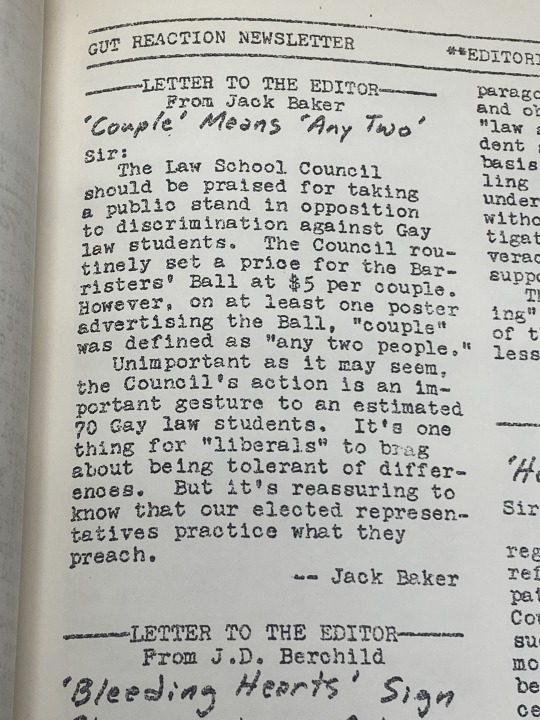
From the archives: In this 1971 issue of the Law School’s student newsletter, Gut Reaction, student Jack Baker wrote to the editor in praise of a small but meaningful gesture made in advertisements for that year’s Barristers’ Ball.
Baker ‘72 and his husband, Michael McConnell, were the first gay couple to be legally married in America in September of 1971.
#UMN law#University of Minnesota Law School#law library#riesenfeld center#jack baker#legal education#barristers' ball#history of legal education#gay law students#gay lawyers#lgbt activism#pride#marriage equality#archives#from the archives#minnesota history#minneapolis history#lgbt history
129 notes
·
View notes
Text
UN Counterterrorism Expert Reports That Conditions at U.S. Guantanamo Detention Facility Are Cruel and Inhuman
On June 14, 2023, the U.N. Human Rights Council’s Special Rapporteur on the Promotion and Protection of Human Rights and Fundamental Freedoms while Countering Terrorism submitted her 24-page, single-spaced report on her four-day visit to the U.S. detention facility in Guantanamo Bay, Cuba.
Summary of the Report[1]
According to the Special Rapporteur, there are “serious concerns about the…
View On WordPress
#Belfast#Fionnuala Ni Aolain#Guantanamo Bay Cuba#human rights#Northern Ireland#Queens University#U.N. Human Rights Council#University of Minnesota Law School
0 notes
Link
The University of Minnesota Law School proudly announced the creation of a “Gun Violence Prevention Clinic”. The announcement on…
1 note
·
View note
Text
Too Little, Too Late - 05/02/2024
Joe Biden finally came out today to address the pro-Palestinian protests that became violent at college campuses across America. He spoke from the White House in an unscheduled speech. “Violent protest is not protected. Vandalism, trespassing, breaking windows, shutting down campuses, forcing the cancellation of classes and graduations. None of this is a peaceful protest. Threatening people, intimidating people, instilling fear in people is not peaceful protest. It’s against the law.” He further said that "dissent is essential to democracy", but that dissent shouldn't lead to chaos.
He was asked by a reporter if the National Guard should be used, he said no. He also spoke out about anti-Semitism and Islamophobia. “There should be no place on any campus, no place in America for anti-Semitism or threats of violence against Jewish students. There is no place for hate speech, or violence of any kind, whether it’s anti-Semitism, Islamophobia, or discrimination against Arab Americans or Palestinian Americans. It’s simply wrong. There’s no place for racism in America. It’s all wrong. It’s not American.” He's right about it being wrong, although I question whether Islamophobia is even a real thing. Yet he wasn't very strong and convincing in my opinion, but what could he really do? He's been trying to placate both sides of the equation because he desperately needs votes from the large Muslim, anti-Semitic populations in Michigan and Minnesota, while he can't alienate the larger populations of pro-Jewish voters. He's painted himself into a corner by trying to please both sides of the equation in his brief, three-and-a-half-minute speech days after these protestors started going too far by threatening violence and taking over some of the schools.
Universities along with state and local police have had to disperse the unruly protestors in several locations throughout the country for the last 3 days before Joey finally came out of his shell and broke his silence. A protest at UCLA was shut down this morning by the Los Angeles Police Department (LAPD) and other California law enforcement agencies after determining that the encampment on the campus was illegal. California governor Gavin Newsom responded on April 30th when the encampment was clashed by pro-Israel protestors, and he said this. “People have the right to get an education, the right to get a degree, the right to walk across the campus safely without fear of being attacked.”
The White House spokesperson, Jean-Pierre said this. “What we believe—and we’re very clear on this—is that peacefully protesting within the law is something that every American should have the right to do. We’re also going to call out any type of anti-Semitism that we are hearing, that we are seeing.” She wouldn't speak to the White House's position on whether they believe there were professional agitators and who could be funding them. She sucks! - In my opinion. And so does Shmoe Bumden, (Joe Biden) he's a compromised lazy bum! - Again, my opinion; what a weak and pathetic president. His response was too little and too late.
#joe biden#jean-pierre#israel#anti semitic#islamophobia#protestors#palestine#pro palestine#ucla#encampment#colleges#universities#america#riots#violence#white house#spokesperson#american#illegal#law enforcement#lapd#los angeles police department#disperse#gavin newsom#california#governor#schools#michigan#minnesota#pro jewish
1 note
·
View note
Text
The Best News of Last Week - March 20, 2023
🌱 - Okra to the Rescue and Other News You Can't 'Lettuce' Miss This Week
1. 4 day work week being pushed in Congress

Progressive Democrats, led by Rep. Mark Takano of California, are pushing for a four-day workweek to give Americans more time for leisure outside of work. The proposed Thirty-Two Hour Workweek Act would amend the Fair Labor Standards Act of 1938 to require overtime pay for any employee working more than 32 hours in a week at a rate of time and a half.
More than 70 British companies have started to test a four-day workweek, and halfway through the six-month trial, most respondents reported there has been no loss in productivity.
2. Governor Walz signs universal school meals bill into Minnesota law

Minnesota just became the fourth state in the US to provide breakfasts and lunches at no charge to students at participating schools! The bill was signed into law by Governor Tim Walz on Friday, and it's set to ease the burden on parents who struggle to provide meals for their children.
The new legislation will cover the cost of meals for all students, regardless of household income. This means that families who don't qualify for free and reduced meals but who struggle to pay for food will also be covered. The bill is also meant to prevent "lunch shaming" practices, where children are denied food or given substitutes that indicate their family is struggling financially.
3. Texas Researchers Use Okra to Remove Microplastics from Wastewater

Researchers from Tarleton State University in Fort Worth, Texas discovered that food-grade plant extracts from okra have the power to remove microplastics from wastewater. Polysaccharide extracts from plants like fenugreek, cactus, aloe vera, tamarind, and okra were found to be effective non-toxic flocculant alternatives to remove microplastics from water.
Polysaccharides from okra and fenugreek were best for removing microplastics from ocean water, while a combination of okra and tamarind worked best for freshwater. Furthermore, plant-based flocculants can be easily implemented in existing water treatment facilities.
4. In the northern California snow, stranded cows are getting emergency hay drops
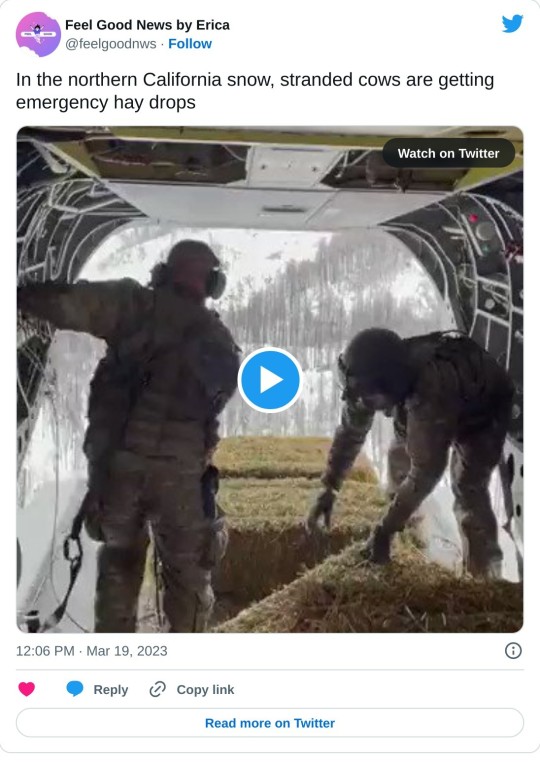
The recent wave of unprecedented snowfall in California has left cattle stranded and starving. When rancher Robert Puga ran out of hay, neighboring Humboldt County officials put together an emergency rescue operation called "Operation Hay Drop." State, federal, and local officials airdropped stranded cattle bales of hay to feed them.
Humboldt County Sheriff William Honsal went to the Coast Guard with the idea of a helicopter rescue, and by midday Sunday, March 5, Operation Hay Drop was underway. So far, Operation Hay Drop has been a success, said rancher Puga. The mission covers about 2,500 head of cattle over several miles.
5. Make-A-Wish Foundation no longer considers Cystic Fibrosis to be automatically qualifying due to improvements in life outcomes for patients
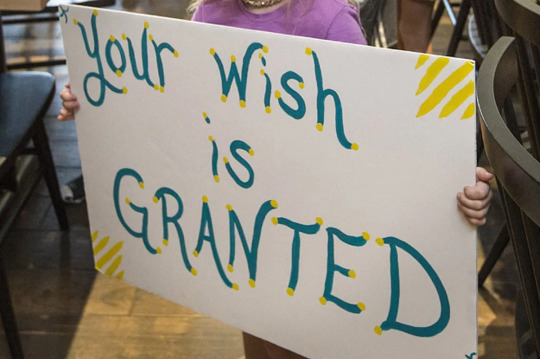
Given the ongoing life-changing advances in cystic fibrosis, beginning in January 2024, cystic fibrosis will no longer automatically qualify for a wish.
6. 1st woman given stem cell transplant to cure HIV is still virus-free 5 years later

In 2017, a woman known as the "New York patient" underwent a stem cell transplant to treat both her cancer and HIV. Now, about 30 months later, she has been virus-free and off her HIV medication, leading some researchers to suggest that she may have been cured of HIV.
The New York patient, received stem cells taken from umbilical cord blood that also had the HIV-resistance genes. However, it's important to note that there is no official distinction between being cured and being in long-term remission, and the medical team is waiting for longer-term follow-up before making any definitive statements.
7. Cheetahs Back in Wild in India After Seven Decades

Namibian cheetahs have been successfully reintroduced to India after the world's fastest land animal was declared extinct in the South Asian country more than 70 years ago. Two cheetahs, Obaan and Asha, were released into the wild of Kuno National Park after being brought to India last September.
The species is being reintroduced on an experimental basis as part of a major prestige project for Prime Minister Narendra Modi. India aims to bring in about 100 of the big cats over the next decade. The African cheetah is a different subspecies from the extinct Asiatic cheetah, which once roamed the sub-continent in great numbers.
Lastly, I recently opened a Youtube channel. Subscribe for a weekly compilation of feel good videos.
- - -
That's it for this week :) If you liked this post you can support me with a small kofi donation:
Buy me a coffee ❤️
Let's carry the positivity into next week and keep spreading the good news!
640 notes
·
View notes
Text
"Surrounded by school children, teachers, advocates and public officials, Gov. Tim Walz signed a bill into law Friday to provide breakfasts and lunches at no charge to students at participating schools. It makes Minnesota the fourth state in the country to do so.
During the signing ceremony, Walz told Minnesota parents this will ease some of the stress on them.
“If you’re looking for good news, this was certainly the place to be,” said Walz. “I’m honored and I do think this is one piece of that puzzle in reducing both childhood poverty and hunger insecurity.”
Lt. Gov. Peggy Flanagan was also at the ceremony. She said this was the most important thing she’d ever worked on.
The legislation is similar to a program that was introduced during the pandemic to provide meals for all students, but was discontinued at the end of last year.
It will cost the state of Minnesota close to $400 million in the first two years and grow in price in the future. It covers the cost of meals, but not of second helpings or of separate a la carte items.
Many — but not all — students in Minnesota qualify for free and reduced meals. That program is based on household income, and if families are below a certain threshold their students can receive school meals for free or for a reduced price...
But even with these measures, there are still families who do not qualify for free and reduced meals but who struggle to pay for food. In many districts this year, that has meant mounting school lunch debts in the tens of thousands of dollars because there are families who don’t qualify for free lunch programs but aren’t able to pay.
This bill would cover all school lunches and breakfasts, even if families don’t meet current federal USDA household income guidelines.
Darcy Stueber is the director of Nutrition Services for Mankato Area Public Schools and she’s also the Public Policy Chair of the Minnesota School Nutrition Association.
Stueber says her district is seeing just over $80,000 in school lunch debt at this point in the year, so there is a definite need families in her area have for this. She says many of those struggling to pay are single-income households that work hard, don’t make enough to pay for meal programs, but make too much to qualify for free meals. Stueber says providing meals is just another basic necessity for learning...
For students in Mankato, Stueber says this will make a big difference in a more relaxed, communal cafeteria. Kids won’t need to worry they’re racking up debts when they eat lunch, she says. And Stueber pointed out that kids aren’t really able to learn well when they’re hungry.
Students will start receiving school meals at no charge starting at the beginning of the next academic year, which starts in September for most schools."
-Minnesota Public Radio News via 3/17/23
#school lunch#debt#usda#poverty reduction#child poverty#food#food insecurity#hunger#united states#minnesota#tim walz#us politics#education#good news#hope
103 notes
·
View notes
Note
what kind of education does one need to get a decent office job. im reconsidering some of my career plan decisions and want to read yuri on the job too
I can’t guarantee reading yuri on the job at any office, I just happened to get lucky(?) with this job and my previous internship. (Although tbh I find even though it comes with time to read yuri or whatever, having to sit in an office for 8 hours a day and watching the clock tick away knowing you have no reason other than your hours to be there is an incredibly frustrating experience at times).
As for what kind of education, I can’t exactly help much there unfortunately. I went with a niche degree that my university offered that only like 30 universities in the US even have programs for. It was a practical decision to enter a field that I don’t actively dislike. Unless you live in Wisconsin or Minnesota (bc MN and WI citizens can go to each others colleges without the absurd additional costs of going to university out of state thanks to a really neat law thingy) and don’t have a specific college in mind I don’t know if I have a recommendation for you that would actually apply.
Really my philosophy was that even if I pursued a career in something I love, it being my job would eventually make me not love it, so instead I chose what was probably the most practical degree at my university in terms of years of schooling + difficulty of courses + cost of tuition compared against the average starting salary out of college for people that have a degree in the field.
I know the advice a decade or so ago was for everyone to go into computer science and IT, but almost all my college friends are guys who went into IT and they tell me that the industry is kind of flooded with people who followed that advice and now the good jobs are somewhat hard to get. So maybe keep that in mind? Take that with a grain of salt though, I’m not in that industry and am just saying stuff secondhand.
Wow I wrote way more than I thought considering I don’t think my advice is too special or noteworthy. I’m hoping yuri on the job is in your future
#also I’ve realized that talking about what my degree is in makes it not too hard to find me if you were dedicated enough#so I don’t really talk about it anymore.#(you can dm me if you really want to know more I suppose)
11 notes
·
View notes
Text
hm
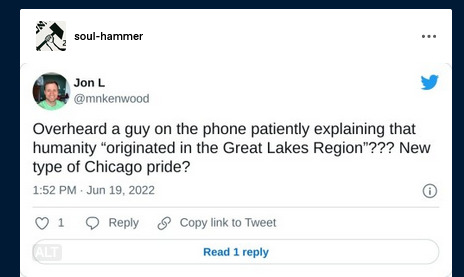
“Chicago pride”? Or white pride, maybe.
Could it have been a reference to the very common/popular white nationalist mound-builder theories from the nineteenth century (and still present today) which tried to explain the existence of Indigenous mound constructions (especially those mounds in Wisconsin, Illinois, and the Great Lakes and Ohio River regions)? The theories proposed that the first human presence in North America was the settlement of people from the Mediterranean or Atlantis, or otherwise some kind of lost race. The theories (argued for publicly by Andrew Jackson, Abraham Lincoln, major scholars, academics, and others) justified imperialist expansion, Manifest Destiny, the Indian Removal Act, etc., and the theories basically helped form the Victorian-era rise of US pop-science among a public grappling with new revelations of geology and deep time/past, and the theories heavily influenced early academic archaeology and medieval studies. Indigenous peoples were considered too “degenerate” to have created such sophisticated architectures, and so a “lost white race” (sometimes proposed to be, like, Paleolithic, Atlantean, Phoenician, Egyptian, Scandinavian, Viking, etc.) must have created the mounds. And throughout the Victorian era and into the Gilded Age, even school textbooks included mentions of this ancient white race/civilization which pre-dated Indigenous presence; the theory influenced notions of Viking settlement in the Great Lakes. The mound builder theories also arguably have found new life in twentieth-century Nazi and contemporary white nationalist interest in “Solutrean” myths and other antisemitic alt-history.
-------
Excerpt:
On December 6, 1830, Andrew Jackson used his second State of the Union address to defend the Indian Removal Act [...]. To his critics who “wept over the fate of the aborigines” [...] Jackson offered an archeology lesson. Any “melancholy reflections” were ahistorical, he said, because the Indians were neither innocent victims nor first peoples, but perpetrators of what Jackson’s modern admirers might call “white genocide.” Jackson knew this because the evidence was everywhere in plain sight. “In the monuments and fortifications of an unknown people, we behold the memorials of a once-powerful race,” said Jackson, “exterminated to make room for the existing savage tribes.” This reference to a “once-powerful race” was not lost on the American public of 1830. Every schoolboy and girl knew it to be the Lost Race of the Mound Builders, believed to be the continent’s original Caucasian inhabitants. From the colonial era into the twentieth century, it was widely accepted that certain earthen structures and burial grounds proved the existence of “white” or Indo-European peoples who settled North America only to be wiped out by the arrival of Jackson’s “savage (Asiatic) tribes.” As the country expanded west, the “Moundbuilders” myth had obvious utility: If the Indians destroyed earlier waves of (white) settlers, their own extermination was just another turn of history’s wheel. In the early 1890s, the U.S. ethnologist Cyrus Vance discredited the theory in a series published by the Smithsonian Institution. But the idea of a pre-Colombian “white genocide” never disappeared. It survived in subcultures, influenced by the occult and Atlantis legends [...]. In 1882 [...] a Minnesota Congressman and writer named Ignatius Loyola Donnelly published Atlantis: The Antediluvian World. The book provided another and more elaborate theory of an Aryan-looking super civilization [...].
Source: Alexander Zaitchik. “Close encounters of the racist kind.” Southern Poverty Law Center. 2 January 2018.
-------
Excerpt:
Although the center of early medieval English studies in the United States was on the east coast […], the first American translation of the poem [Beowulf] was completed at the University of Wisconsin, on the lakeshores of Teejop. [...]. One of the poem’s first American readers was Harvard University professor of modern languages Henry Wadsworth Longfellow. In 1838, Longfellow reviewed Beowulf in the North American Review: “It is like a piece of ancient armour; rusty and battered, and yet strong.” The poem is an old, Gothic war-ruin, haunted by ancient spirits of folk heroes, seemingly foreshadowing Longfellow’s own saga of “Viking America,” the ballad “The Skeleton in Armor” (1841). [...] The public land-grant University of Wisconsin-Madison […] occupies stolen ancestral Ho-Chunk land on the shores of Lakes Mendota and Wingra. On campus are multiple effigy mound groups built by the ancestors of the Ho-Chunk people […]. In the “long nineteenth century,” medieval studies was an important touchstone for antiquarian and archaeological study of Indigenous mounds and the peoples who built them. [...].At the time many amateurs and scholars alike denied Indigenous mounds were the works of First Nations peoples. Some writers identified Indigenous mounds as the works of Phoenicians, Israelites, Hindus, Welsh, or Norse Vikings. [...] [F]orced removals and Indigenous resistance continued in the state [Wisconsin] as late as 1874. The same year, University of Wisconsin professor of Scandinavian studies Rasmus Born Anderson published the popular book America not Discovered by Columbus: A Historical Sketch of the Discovery of America [...].
Source: Maxwell Gray. “Beowulf in Teejop.” Edge Effects. 16 February 2021.
-------
Excerpt:
How could such a “primitive” people of neither Caucasian or Semitic ancestry possibly have constructed such impressive monuments? The answer, clearly, was that they hadn’t. Rather the mounds were the product of another “lost race” – presumably a white one – which had been wiped out by the present “savages.” This kind of racist thinking would eventually lead to the dangerous and genocidal notion that North America had been a white country in antiquity. The Native Americans were not the original inhabitants, but squatters [...]. Over time, this idea developed further and got progressively stranger. Who was the lost white race? Viking explorers – as proposed by frustrated writer Ephraim George Squier? Children of the biblical Nephilim – as suggested by none other than Abraham Lincoln? Refugees from Atlantis – as popularized by Minnesota Congressman Ignatius Donnelly? In 1833 Josiah Priest [...] claimed that the fabled mound builders had been white (and the true inventors of gun powder, not the Chinese!), but that dozens of ancient, old world peoples had visited America before the time of Columbus. This included, but was not limited to, Greco-Romans, Egyptians (who left mummies entombed in secret catacombs in Kentucky), and a Welsh Prince. Amazingly, by 1847, material from Priest’s fictitious pseudo-history had made its way into some American school textbooks.
Source: Justin Mullis. “”The Mound Builder Myth: Fake History and the Hunt for a ‘Lost White Race’” -- book review.” AIPT Science. 31 May 2020.
361 notes
·
View notes
Text
Some excerpts about various college protests:
Law enforcement have arrested more than 20 people on the University of Texas at Austin campus, according to a statement from the Texas Department of Public Safety.
...
Harvard University has joined the growing list of American universities holding solidarity encampment protests.
Harvard Out of Occupied Palestine, a group that describes itself on Instagram as a "coalition of Harvard students fighting for divestment and a #FreePalestine," posted today that it established a "liberated zone" on campus, joining a slew of other campuses across the country.
...
Police responded to the encampment protest and were seen taking down tents at the University of Southern California this afternoon — hours after student activists started their demonstration in solidarity with the Palestinian cause.
...
Peace and environmental activist Naomi Klein, who is Jewish, joined hundreds of antiwar demonstrators outside New York Sen. Chuck Schumer's home Tuesday night for an "emergency" Seder.
...
Dr. Chenjerai Kumanyika, an assistant professor of journalism at NYU, said he and other faculty members went to support students protesting in support of Palestinians yesterday when ranks of “intimidating” helmeted police officers closed in and arrested them.
”I can’t even count how many police. Then they arrested faculty and they violently arrest students, and sort of destroyed this academy that the students had set up. Took all of us down to One Police Plaza, the NYPD headquarters, and everyone was charged with trespass,” he said.
Kumanyika said students were grabbed, handcuffed with zip ties and officers were seen throwing chairs.
Student protesters at the University of California's Berkeley campus joined students across the country yesterday in demanding their school cut all ties with Israeli institutions.
The Berkeley protesters have camped out for the last two days in opposition to the war in Gaza."I guess I'm not super surprised. I mean, it is Berkeley, things like this are happening all the time. The only thing that's surprising me is, it's this late in the semester," UC Berkeley student Any Bass told KNTV, NBC News' affiliate in the Bay Area.
....
An encampment protest started this morning at Brown University in Providence, Rhode Island, with about 90 students seen joining shortly after 6 a.m., the school said.
Nine people were arrested at the University of Minnesota’s Twin Cities campus yesterday, the institution said this morning.
Some students had set up an encampment on the north end of Northrop Mall and were warned by police early yesterday to disperse or be arrested. Some chose to disperse while others chose to remain and peacefully protest before they were arrested and later released.
#palestine#israel#gaza#columbia university#brown university#new york university#berkely#University of Southern California#Harvard#University of Texas
5 notes
·
View notes
Text


Some unexpected marbling on two books (here and here) covering the trial of Lord Sackville, 1760.
#riesenfeld center#umn#university of minnesota law#university of minnesota law library#umn law#rare books#archives#special collections#law school#old books#marbling#beautiful book covers
193 notes
·
View notes
Text
Are Red State Universities Starting to Feel the Pressure? An Anecdotal Account
As a member of academia, I periodically get inquiries from other law schools asking if I'm interested in lateralling. This is quite flattering, though I know full well that such messages aren't only being sent to me and that there is a long road from "email of interest" to actually getting a job offer.
Recently, though, I've noticed that the schools making such inquiries of me are disproportionately located in deep red, southern states. It could be a statistical artifact, of course -- I don't get so many solicitations so as to negate the possibility of random clustering. But it does make me wonder if the decaying political climate in those states means that these schools are experiencing more pressure in terms of faculty outflow, which they're trying to replace via laterals.*
Both the specific anti-academia initiatives (crusades against "controversial topics"; attacks on tenure), and the broader threat to political and civil rights (abortion bans, threats to democracy) that are characteristic of these states make working there -- and to be clear, I hold the universities in question in the highest esteem -- a far less attractive proposition. And from the other side of the fence, serving on our school's appointments committee this year it did seem to me like we were getting an uptick in "red state refugee" lateral applications -- though again, that's just an impression, and I have no data to back it up. For another bit of anecdotal evidence, see Sapna Kumar's recent interview explaining why she elected to leave Houston Law for the University of Minnesota.
I'm curious, though, if others are noticing this pattern as well. Other junior law professors -- are you getting disproportionate interest from "red state" schools? Any other sense that these schools are indeed facing faculty outflow pressure?
For what it's worth, I'm very happy in Portland and at Lewis & Clark, and have no interest in decamping anywhere. My wife and I have bought a house, we've settled down, I like my students and my colleagues, I've got the course package I want -- life is good and I see no need to mess with a happy status quo.** But my wife and I have also decided that, even beyond any generic inertial resistance, we're in particular not interested in moving to schools in places where our basic rights don't feel secure. We're at the phase of life where we're thinking of starting a family, and doing that in a place where pregnancy turns my wife into a vessel for the state would be horribly unfair to her. And for my part, I teach constitutional law -- a course that, rumor has it, sometimes veers into "controversial topics". I don't want to go to jail because some yahoo right-wing prosecutor decides I'm teaching Roe and Dobbs wrong.
* It might say something about my professional self-esteem that I assume the only reason these schools would be interested in the likes of me is that they're in the midst of a political crisis.
** All that said, I want to be very clear that if Harvard Law School wanted to entice me to move to Cambridge by tripling my salary, they can feel free to mess away.
via The Debate Link https://ift.tt/gJTALNB
18 notes
·
View notes
Text

Republicans complain about "cancel culture" while attempting to ban anything and everything they don't like.
A likely response to this graphic is disbelief, so here is some supporting documentation to help with any discussions:
Abortion:
https://truthout.org/articles/senator-republicans-will-100-percent-pass-abortion-ban-if-they-win-congress/
https://www.reuters.com/world/us/trump-privately-favors-16-week-national-abortion-ban-new-york-times-reports-2024-02-16/
Affordable Healthcare:
https://apnews.com/article/trump-obamacare-health-care-biden-c2b1f5776310870deed2fb997b07fc2c
https://ballotpedia.org/Republican_and_conservative_proposals_to_repeal_the_Affordable_Care_Act_(Obamacare)
https://www.whitehouse.gov/briefing-room/statements-releases/2023/02/28/fact-sheet-the-congressional-republican-agenda-repealing-the-affordable-care-act-and-slashing-medicaid/
Gay Marriage:
https://www.vox.com/23274491/senate-republicans-same-sex-marriage-bill-respect-for-marriage-act
https://time.com/6240497/same-sex-marriage-rights-us-obergefell/
Birth Control:
https://slate.com/news-and-politics/2023/04/birth-control-is-next-republicans-abortion.html
Books:
https://newrepublic.com/article/175372/banned-books-republican-right-wing-war
https://www.latimes.com/world-nation/story/2023-04-22/book-bans-soaring-schools-new-laws-republican-states
https://www.theguardian.com/commentisfree/2023/dec/09/republican-book-bans-censorship-free-speech
Minorities Voting:
https://en.wikipedia.org/wiki/Republican_efforts_to_restrict_voting_following_the_2020_presidential_election
https://www.npr.org/2018/10/23/659784277/republican-voter-suppression-efforts-are-targeting-minorities-journalist-says
https://www.usnews.com/news/politics/articles/2022-01-19/republicans-block-voting-rights-bill-again-triggering-action-on-filibuster-reform
Muslims:
https://www.rollingstone.com/politics/politics-features/donald-trump-muslim-ban-immigration-2024-1234730150/
Protests:
https://www.npr.org/2021/04/25/990710251/republicans-push-wave-of-anti-protest-bills-in-alternative-universe-backlash
https://www.vanityfair.com/news/2021/04/gop-anti-protest-bills
https://www.nbcnews.com/news/us-news/tennessee-republicans-trying-expel-democratic-lawmakers-supported-gun-rcna78103
Refugees:
https://www.cbsnews.com/news/senate-republicans-asylum-limits-funding-bill/
https://www.pbs.org/newshour/politics/house-republicans-pass-new-asylum-seeker-restrictions-as-title-42-ends-biden-promises-veto
Trans People:
https://www.reuters.com/world/us/us-republican-transgender-laws-pile-up-setting-2024-battle-lines-2023-05-18/
https://apnews.com/article/transgender-health-care-republican-legislatures-5d98832c0234de079263672c738e0631
Unions:
https://truthout.org/articles/republicans-say-theyll-go-after-labor-movement-if-they-take-control-of-house/
https://www.cnbc.com/2023/06/22/new-senate-bill-targets-national-labor-law-and-port-union-workers.html
https://www.cbsnews.com/minnesota/news/collective-bargaining-ban-in-wisconsin-under-attack-by-unions-after-supreme-court-majority-flips/
Words:
https://apnews.com/article/desantis-florida-dont-say-gay-ban-684ed25a303f83208a89c556543183cb
https://www.esquire.com/news-politics/a37804650/wisconsin-legislature-police-speech-schools-critical-race-theory/
https://www.theguardian.com/commentisfree/2015/mar/11/republican-new-climate-change-strategy-ban-words-climate-change
https://www.edweek.org/policy-politics/heres-the-long-list-of-topics-republicans-want-banned-from-the-classroom/2022/02
https://apnews.com/article/sarah-huckabee-sanders-politics-united-states-government-arkansas-hispanics-4f23386e609acd8206d2396719c17cab
3 notes
·
View notes
Text
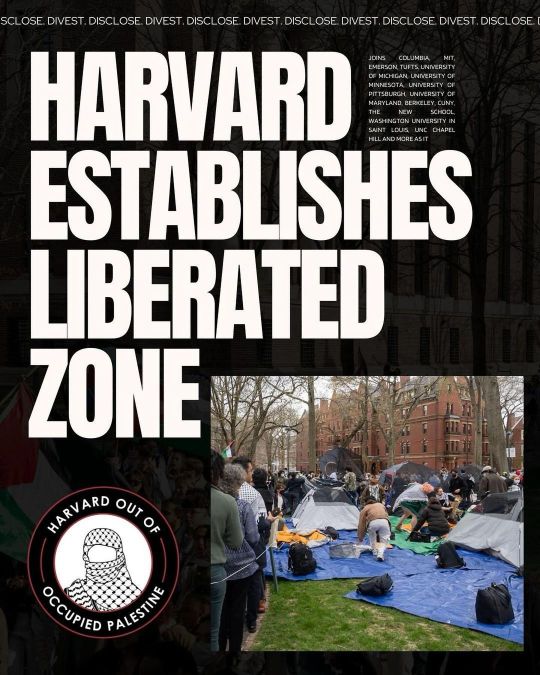
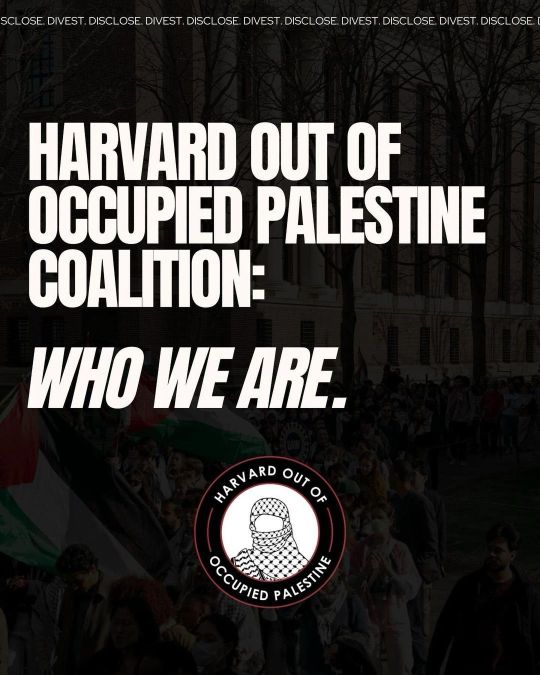



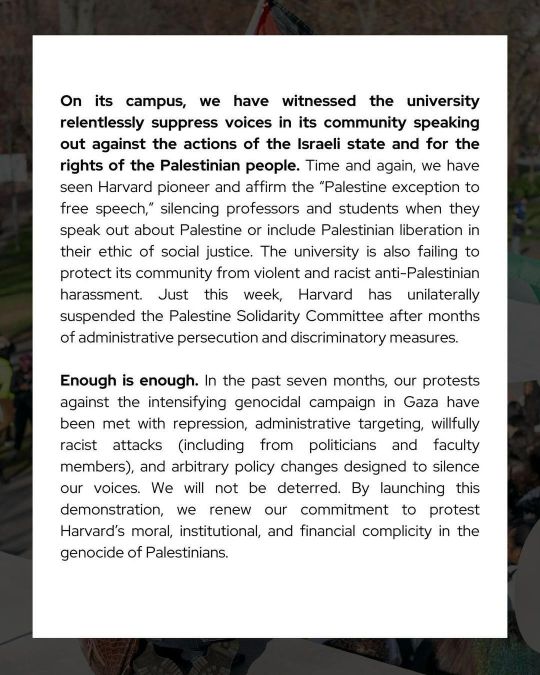

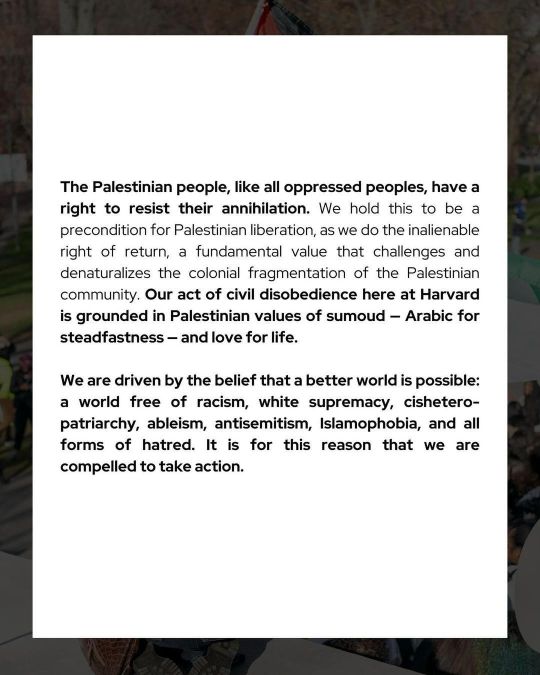
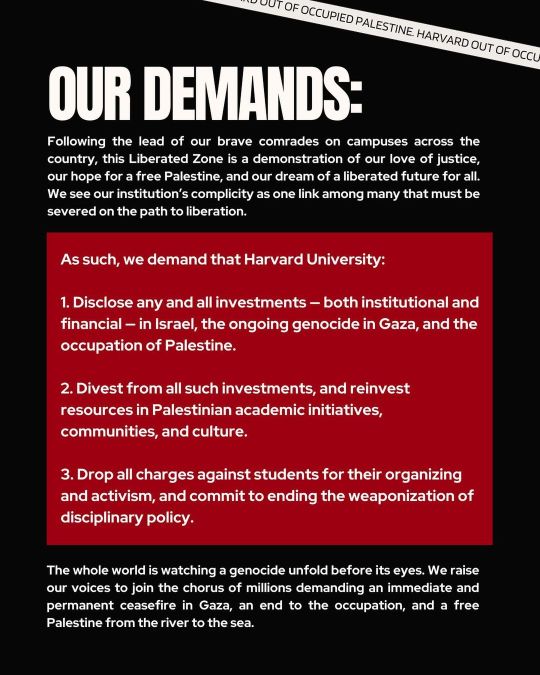
Uploaded on Instagram by harvxrdpsc on April 24, 2024.
------------------------------------------------------------------------------
[id: photo text
1st:
Harvard joins Columbia, MIT, Emerson, Tufts, University of Michigan, University of Minnesota, University of Pittsburgh, University of Maryland, Berkeley, Cuny, The New School, Washington University in Saint Louis, UNC Chapel Hill and more as it establishes Liberated Zone
The bold text makes it look like ‘HARVARD ESTABLISHES LIBERATED ZONE’
2nd:
Harvard Out of Occupied Palestine Coalition: Who We Are.
3rd:
We, the Harvard Out of Occupied Palestine Coalition, are a group of students and student workers at Harvard University committed to Palestinian liberation. We are part of a rich tradition of students who stood up to U.S. imperialism in Vietnam and Iraq, rallied against apartheid in South Africa, fought for Black liberation in the United Staes, and built national living wage campaigns on university campuses. We understand that all of our historic movements for freedom and justice are intertwined. The Palestinian cause if not for Palestinians alone – it is a cause for people of conscience, concerned with humanity, freedom, and justice.
We have established this Liberated Zone to call for an end to Harvard’s moral and material complicity in the ongoing genocide of the Palestinian people.
Over the past seven months, we have witnessed Israel and the United States unleash unimaginable cruelty in Gaza. As we write this, Israel has murdered more than 34,000 Palestinians, including 14,000 children. Every day brings more horrifying images than the last: families facing starvation, people undergoing amputation without anesthesia, newly discovered mass graves, entire neighborhoods reduced to rubble.
4th:
These atrocities are not new. Since the original Nakba – Arabic for catastrophe – of 1948, when 750,000 Palestinians were ethnically cleansed from their land, Palestinians have been dispossessed and fragmented by a pernicious apartheid regime, a brutal military occupation, and a suffocating blockade. Zionism, the political project rationalizing this violence, requires the subjugation of Palestinian life and the continued colonialization of Palestinian land. There can be no equivocation: Palestine is occupied from Gaza to the Galilee, from the Jordan River to the Mediterranean Sea.
This oppression is co-signed and co-sponsored by the United States government and its institutions. The U.S. continues to sustain the Zionist colonial regime with billions of dollars in military funding. Since its founding, Israel has been the largest cumulative recipient of U.S. foreign aid, receiving approximately $300 billion in economic and military assistance.
5th:
As we walk the halls of Harvard, study in its libraries, and sleep in its dormitories, we are acutely aware that there are no universities remaining in the Gaza Strip. Israel has robbed Palestinians of their rights to education by systematically destroying academic infrastructures and communities. Professors, teachers, students, and academic workers have been targeted and killed along with the rest of Gaza’s population. As students, educators, and graduate workers, we have a duty to fight against this genocide.
Palestine is not only a moral issue. It is an issue that affects our campus, one that fundamentally implicates Harvard University. As of 2019, Harvard had invested at least $200 million in companies with ties to illegal Israeli settlements, a flagrant violation of international human rights law, and at least $86,625 worth of investments in the Israeli military. Today, the Harvard Management Company, which oversees the world’s largest university endowment of $51 billion, discloses no information about the scale of natures of its investments in Israel.
6th
On its campus, we have witnessed the university relentlessly suppress voices in its community speaking out against the actions of the Israeli state and for the rights of the Palestinian people. Time and time again, we have seen Harvard pioneer and affirm the “Palestine exception to free speech,” silencing professors and students when they speak out about Palestine or include Palestinian liberation in their ethic of social justice. The university is also failing to protect its community from violent and racist anti-Palestinian harassment. Just this week, Harvard has unilaterally suspended the Palestine Solidarity Committee after months of administrative persecution and discriminatory measures.
Enough is enough. In the past seven months, our protests against the intensifying genocidal campaign in Gaza have been met with repression, administrative targeting, willfully racist attacks (including from politicians and faculty members), and arbitrary policy changes designed to silence our voices. We will not be deterred. By launching this demonstration, we renew our commitment to protest Harvard’s moral, institutional, and financial complicity in the genocide of Palestinians.
7th:
As student governments in schools across Harvard pass resolutions for divestment, the University must contend with the facts that its students will not tolerate its support for genocide, violence, and apartheid. In doing so, we proudly continue Harvard’s legacy of anti-war, anti-racist student organizing, from the mock “shanty towns” established in Harvard Yard in 1986 to protest apartheid in South Africa, to the 1969 University Hall occupation protesting against the war on Vietnam.
Our movement is one part of the tapestry of liberation movements. Harvard itself is a product of land theft and indigenous erasure: the initial funds to establish this university were used for the ‘education and conversion’ of indigenous people. By creating this Liberated Zone, we hope to begin the work of building the world we want to inhabit: a world free of the shackles of colonialism.
8th:
The Palestinian people, like all oppressed peoples, have a right to resist their annihilation. We hold this to be a precondition for Palestinian liberation, as we do the inalienable right of return, a fundamental value that challenges and denaturalizes the colonial fragmentation of the Palestinian community. Our act of civil disobedience here at Harvard is grounded in Palestinian values of sumoud – Arabic for steadfastness – and love for life.
We are driven by the belief that a better world is possible: a world free of racism, white supremacy, cishetero-patriarchy. Ableism, antisemitism, Islamophobia, and all forms of hatred. It is for this reason that we are compelled to take action.
9th:
Our demands: Following the lead of our brave comrades on campuses across the country, this Liberated Zone is a demonstration of our love of justice, our hope for a free Palestine, and our dream of a liberated future for all. We see our institution’s complicity as one link among many that must be severed on the path to liberation.
As such, we demand that Harvard University:
1. Disclose any and all investments – both institutional and financial – in Israel, the ongoing genocide in Gaza, and the occupation of Palestine.
2. Divest from all such investments, and reinvest resources in Palestinian academic initiatives, communities, and culture.
3. Drop all charges against students for their organizing and activism, and commit to ending the weaponization of disciplinary policy.
The whole world is watching a genocide unfold before its eyes. We raise our voices to join the chorus of millions demanding an immediate and permanent ceasefire in Gaza, an end to the occupation, and a free Palestine from the river to the sea. /id]
6 notes
·
View notes
Photo

In 1977, residents of South Minneapolis mobilized to fight the expansion of adult entertainment businesses along Lake Street. In 1983, after years of unsuccessful protest, these activists sought help from nationally known feminist theorists Catharine MacKinnon and Andrea Dworkin. MacKinnon and Dworkin wrote a controversial amendment to the city's expansive civil rights ordinance that defined pornography as a violation of women's civil rights.
In the late 1960s, a pair of Minneapolis entrepreneurs named Ferris and Edward Alexander sensed opportunity. In 1969, the brothers bought the Rialto Theater on Lake Street. Once a destination for family moviegoers, the theater began screening movies like Deep Throat. Soon a bookstore opened next to the theater. An adult entertainment district began to take shape on Lake Street.
The Alexanders enjoyed a virtual monopoly on the distribution of pornography in Minnesota. They owned a string of businesses across the state. But these Lake Street storefronts would serve as the core of what one newspaper called their "empire of smut."
The cluster of pornographic bookstores and theaters attracted men from all over the Twin Cities. There, they watched movies, read magazines, and sought sexual encounters with both prostitutes (men as well as women) and other patrons.
Residents of the Powderhorn and Central areas were dismayed by the way these businesses altered the climate of their neighborhoods. They objected most to customers harassing women on the surrounding streets.
In 1977, residents mobilized in protest and organized a picket line. City officials responded with a zoning ordinance that outlawed the operation of adult bookstores and theaters within five hundred feet of churches, schools, or residential areas. The injunction would have forced the Alexander brothers to close most of their businesses. The brothers sued the city and won.
In the wake of this ruling, activists regrouped in 1979. Instead of picketing, women volunteers organized themselves into action groups they wryly called "afternoon bridge clubs" and "sewing circles." They spent several hours each week "browsing" bookstores. Like temperance activists in the nineteenth century, they saw how the mere presence of women disrupted an all-male environment. They were courteously confrontational. They greeted people at the door and stood "behind customers, watching customers watch the quarter movies."
Police and city officials sympathized with the protesters. But instead of fighting street harassment, police focused on the men inside the bookstores who sought sexual encounters with other men. Between 1979 and 1985, they arrested over thirty-five hundred men for "indecent conduct."
By 1983, the Lake Street pornography district was still flourishing. Frustrated activists decided to seek help from Andrea Dworkin and Catharine MacKinnon, two nationally-known feminist theorists who argued that pornography scripted women's oppression. The women were living in Minneapolis for a time while they taught a class at the University of Minnesota law school.
Dworkin and MacKinnon brought new life to the anti-pornography campaign when they called for what opponents saw as a de facto ban. They appeared before the city zoning committee in October 1983. Pornography, they argued, was a crime against women. The city council hired them to amend the Minneapolis civil rights ordinance to define pornography as “the sexually explicit subordination of women, graphically depicted” and "a form of discrimination on the basis of sex." The amendment allowed those who had been harmed by pornography to sue its producers and purveyors.
For the next two months, debate over the measure consumed the city. On December 30, 1983, the city council approved the ordinance in a seven-to-six vote. Six days later, it was vetoed by Mayor Donald Fraser, who argued it would never hold up to judicial review.
Dworkin and MacKinnon used the publicity generated by the measure to launch a national campaign. Cities all over the country considered adopting the ordinance they wrote in Minneapolis.
After the mayor's veto, debate over pornography continued to rage in the city. In January 1984, Fraser created the Task Force on Pornography to find consensus on the issue. After a series of meetings, the body proposed a new version of the ordinance, drawing fire from Dworkin and MacKinnon. The pair countered with another measure which offered a narrowed definition of pornography and a less ambitious "trafficking" provision.
In July, the city council approved the new ordinance. The mayor immediately vetoed it.
In 1986, the U. S. Supreme Court affirmed a lower-court decision that declared such measures to be unconstitutional.
https://www.mnopedia.org/thing/minneapolis-anti-pornography-ordinance
19 notes
·
View notes
Text
Supporters of gun safety legislation held rallies across the state of Michigan this week, including one in Oxford, a northern Detroit suburb that was the site of a high school massacre in November 2021.
Among the speakers there was Madeline Johnson, a survivor of the shooting who saw her best friend die. She talked about the fear of public speaking she once had ― and how that fear was “ripped away from me, along with my childhood, the second I heard the first round of bullets ringing in my ears.”
“There are much scarier things in this world than giving speeches,” she said, according to an account in The Detroit News. “I no longer have room in my life to be a kid, but I will gladly sacrifice that, and I will gladly talk until you listen, so that no one else has to grow up overnight.”
The frustration from Johnson and other gun legislation advocates was palpable, and a reflection of what’s transpired ever since the Oxford shooting ― when, despite the familiar outpouring of “thoughts and prayers,” the Republicans who controlled the state legislature refused to act.
But that may be about to change, because Republicans don’t control the legislature anymore. Democrats do. In the midterm elections, they won majorities in both Michigan’s House and its Senate, something they haven’t had since the 1980s.
Democratic leaders have made it clear they want to pass a trio of gun laws: universal background checks, new gun storage requirements, and so-called “red flag” laws meant to keep firearms out of the hands of people who pose an immediate threat to others or themselves. Newly reelected Democratic Gov. Gretchen Whitmer has said these are high priorities for her too.
These reforms are part of a broader agenda that Whitmer and the newly empowered Democrats hope to pass, now that they can finally act. It includes everything from a boost in tax credits for working families to codifying protections for reproductive rights.
And it’s not just Michigan where this kind of activity is likely to take place. You’ll hear similar plans from Democratic officials in other states where they have the power to pass laws ― especially the three others (Maryland, Massachusetts and Minnesota) where, as in Michigan, Democrats are getting that power for the first time in years.
Of course, passing laws is never as easy as promising them. The exercise of moving from slogans to specifics ― of translating abstract concepts into statutory details ― is inevitably difficult, especially on issues where the opposition is well-financed and well-organized.
But in today’s political environment, Democrats have a big advantage: On many of the key issues they are tackling at the state level, they appear more in step with mainstream popular opinion than the Republicans.
Gun safety is one of those issues.
24 notes
·
View notes
Text
MADISON, Wis. (AP) — After years of opposition to any form of marijuana legalization in Wisconsin, Republican lawmakers are now working privately to build support for a medical cannabis program that could win bipartisan backing and be enacted into law later this year, Assembly Speaker Robin Vos told The Associated Press on Thursday.
For now, the group of lawmakers — whom Vos declined to name — are working only among Assembly Republicans to build enough support, and he hopes to introduce the plan this fall. Vos has long backed some form of medical marijuana program, but no bill has ever received a vote in either the GOP-controlled Assembly or Senate.
Vos said he remains steadfastly opposed to legalizing recreational marijuana and does not want to create a medical program that would be a precursor to that. Wisconsin remains an outlier nationally, with medical marijuana legal in 38 states and recreational marijuana legal in 21. The push for legalization in Wisconsin has gained momentum, as neighboring Illinois and Michigan allow recreational use while Minnesota and Iowa have legalized medical use.
“We are not Illinois. We are not California. We are not Colorado,” Vos said in an interview. “We are a state that’s at best purple. And purple is not legalization of recreational marijuana.”
Vos’s announcement that Republicans have been working on a deal he hopes can pass the Legislature comes on April 20, or “420 Day,” marijuana’s high holiday. Advocates for pot legalization planned to announce a “Grass Routes Tour” that will make four stops across the state to promote cannabis legalization.
Democratic Senate Minority Leader Melissa Agard, who is leading the fight for full legalization, cast doubt on Vos’ intentions.
“We’ve seen this story before — but actions speak louder than words,” Agard said in a statement. “Session after session, the Speaker has come forward with empty promises but no tangible steps toward any form of legal cannabis Wisconsin.”
Democratic Gov. Tony Evers proposed full legalization of marijuana in his state budget, an idea that Republicans vowed to reject. Last April 20, a Republican-authored bill creating a medical marijuana program received a public hearing, the first time any such bill made it that far in the GOP-controlled Legislature.
However, the bill died in committee.
Senate Republicans have been less open to pot legalization than those in the Assembly. But in January, Senate Majority Leader Devin LeMahieu said a bill to create a medical marijuana program could pass this legislative session — as long as regulations are put forward to ensure it’s for those in serious pain.
Sixty-four percent of Wisconsinites support legalizing marijuana for any use, according to October polling by the Marquette University Law School. More than 80% of Wisconsinites supported the idea of a medical marijuana program, according to 2019 polling.
13 notes
·
View notes